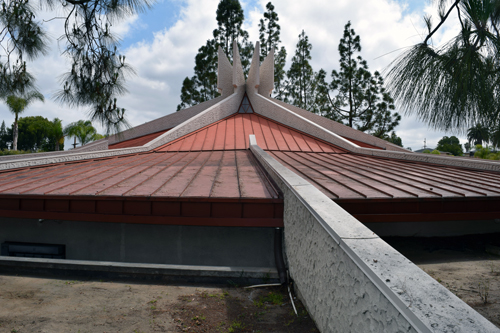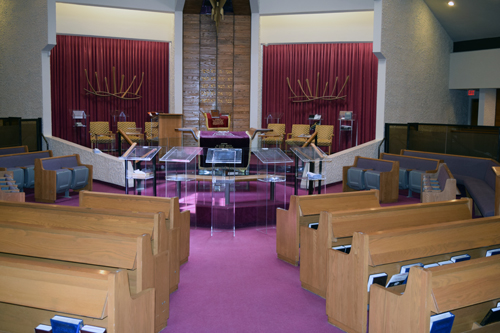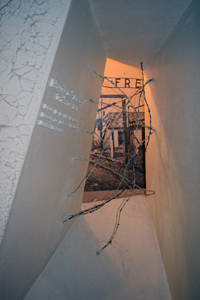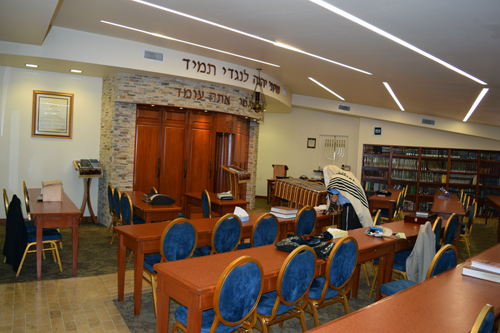History of Beth Jacob San Diego
Our Rich History
From Humble Beginnings to a Growing Community
Beth Jacob Congregation was founded in 1939. In May of that year, a small house on Myrtle Avenue was purchased to serve as a hub for religious services and congregational meetings. This marked the beginning of our vibrant community.
In 1947, Rabbi Baruch Stern joined Beth Jacob and served as our dedicated rabbi until his retirement in 1977. Under Rabbi Stern's leadership, the Congregation embarked on a significant project, constructing a new synagogue on 30th Street near Meade Avenue, which was completed in 1950.

The original Beth Jacob Synagogue on 30th Street.
Our Home on College Avenue
As our congregation continued to grow, the need for a larger space became evident. In 1972, Beth Jacob broke ground for a new synagogue, strategically located on College Avenue in close proximity to San Diego State University. After several years of dedicated effort and commitment from many members, the new synagogue was completed. Dedication services were proudly held on August 28, 1977.

Our synagogue on College Avenue stands as an extraordinarily beautiful building, a testament to our community's vision and perseverance. It serves as a spiritual anchor for hundreds of families in San Diego.
Artistry and Symbolism in Our Sanctuary
The Beth Midrash (study hall) is adorned with four stunning faceted glass windows. These intricate panels depict highlights from Jewish history and tradition:
- Scenes from the Garden of Eden and the Exodus from Egypt.
- The building and subsequent destruction of the Holy Temple.
- The return to and rebuilding of Israel.
- Symbols of Shabbat and various Jewish festivals.
The designer meticulously used "rich colors and textures of one-inch thick glass chipped at the edges in bold, mosaic style," creating a narrative flow through time. At sunset, the faceted glass catches the sun's rays, bathing worshippers in the rich colors of Jewish history, a truly inspiring sight.

Window panel depicting early Jewish history.

Window panel continuing the historical narrative.

Window panel showing temple and destruction.

Window panel depicting the return and rebuilding of Israel.
Our sanctuary's beauty has even been featured! Beth Jacob Congregation commissioned a postcard showcasing its sacred space.

Postcard featuring Beth Jacob's beautiful sanctuary.
Beth Jacob is a proud member synagogue of the Orthodox Union.
Beyond the Surface: Symbolism in Our Architecture

One of the most distinctive features of Beth Jacob Congregation is the unusual protrusion from its red roof. Many believe it represents the stem of a pomegranate, a fruit deeply symbolic in Jewish tradition. The pomegranate's many seeds are said to represent the 613 mitzvot (commandments) of the Torah and, as Synagogue Administrator Rand Levin noted, "all the various people inside. Not one, but many, bringing a sweetness to the congregation."

Pomegranate: a symbol of fruitfulness and mitzvot.
The textured walls of the synagogue, both inside and out, are said to represent the times when Jews "wail and cry when we pray."

Textured walls and Beth Jacob's Hebrew name.
Triangular patches of ground around the synagogue provide areas for contemplation and recreation, including the Israel Garden. This special garden nurtures a real pomegranate tree, along with a fig tree, olive tree, palm tree, and grapes—five of the seven species of Israel. It has become "a real serenity garden," a place for community members to gather and converse. A small playground offers recreation for all ages.

The Israel Garden at Beth Jacob featuring five of the seven species.
Inside the Steiman Sanctuary

The main Beth Jacob Sanctuary, named for Morrie and Barbara Steiman.
The Steiman Sanctuary, named posthumously for philanthropists Morrie and Barbara Steiman, comfortably seats 300 people, with men in the middle and women on the two sides, adhering to Orthodox practice. Every element within the sanctuary is steeped in symbolism.
Upon the Aron Kodesh (Holy Ark), engraved representations of the Ten Commandments are prominently displayed. When the doors are opened to reveal the Torah scrolls, these sacred words of God also appear on the fold-out sides, ensuring they are always before the congregation.

Rand Levin inside the Aron Kodesh, 2015.
The Ner Tamid, or Eternal Flame, above the Ark has a fascinating legend: a glass ball at the top is said to be attached to a motor, turning to give the effect of a dancing flame when light hits it, a feature installed in 1977.
Large, matching seven-branched menorahs flank the Holy Ark. These were created after an electrical fire destroyed a sanctuary wall, from which the Torahs were heroically rescued. Across from the Ark is the Shulchan (reader’s table), where prayer leaders conduct services and read from the Torah, facing East along with the congregation. Shtenders (reading stands) are available for congregants at the front to easily access their siddurim (prayer books) and Chumashim (Bibles) within easy reach.
At the back of the room, paneled walls can open to enlarge the sanctuary for High Holy Day services and other occasions with larger crowds. Otherwise, these overflow spaces serve various purposes, including study and rehearsals.
Remembrance and Reflection: Our Memorials
Both inside and outside our synagogue, sacred memorials stand as reminders of our history and the resilience of the Jewish people.

Wall niche symbolizing concentration camps.
Inside a wall niche, a powerful Holocaust memorial features a photograph of a concentration camp entrance, with barbed wire conveying the terror of that era. In one of our gardens, a memorial erected by Russian-speaking members of the congregation honors those lost in World War II.

Russian memorial to WWII losses.
The Beit Midrash and Community Facilities
The beit midrash, our dedicated study hall, also serves as a space for daily minyans (prayer services). Its back wall features four stunning stained glass windows, mirroring those described earlier, which depict key moments in Jewish history.

A space for prayer and study in the Beit Midrash.

Stained glass windows in the Beit Midrash, beginning with the Garden of Eden.
Adjacent to the entrance foyer is a large social hall, supported by Beth Jacob’s own kosher kitchen. This kitchen is available for rent by approved kosher caterers, providing an additional revenue stream for the synagogue, with Rabbi Bogopulsky serving as the mashgiach (kosher supervisor) for these events.
Supporting Our Community: Apartments & Outreach

A significant revenue source for Beth Jacob is a block of 50 apartments located on our campus. These units are rented to congregants seeking to live within walking distance of services, as well as to San Diego State University students and other members of the general public. This diverse community reflects our welcoming ethos, as Rand Levin noted, "We don’t discriminate... it is a very diverse community.” Tenants are free to prepare non-kosher food in the privacy of their homes.
History and modernity, spirituality and pragmatism, exist side by side at Beth Jacob Congregation. Our goal is not just to service members, but the entire Jewish community, with the hope that those we serve will one day become members.
Our Esteemed Rabbinical Leadership and Dedicated Staff

Rabbi Avram Bogopulsky currently leads Beth Jacob Congregation, marking him as only the third rabbi to serve our Orthodox institution since its transition after World War II. Beth Jacob was originally founded as a Conservative congregation in the late 1930s but changed affiliations concurrently with Tifereth Israel Synagogue's move from Orthodox to Conservative.
Rabbi Baruch Stern, a Holocaust survivor who had trained at Tifereth Israel, became Beth Jacob's first Orthodox rabbi in 1947. He gracefully allowed some previous customs, like mixed seating to continue until his retirement in 1977, which coincided with our move to the College Avenue building.
Rabbi Eliezer Langer succeeded Rabbi Stern, implementing mechitzahs in the new building to align Beth Jacob with contemporary Orthodox practice. After accepting an assignment in Israel, Rabbi Langer was succeeded in 1996 by Rabbi Bogopulsky.
Rabbi Bogopulsky's journey to ordination included studies under Rabbi Berel Wein and Rabbi Laibel Reznick, whose inspirational words instilled in him a profound desire to serve Klal Yisrael (the Jewish people).
Today, Rabbi Bogopulsky is supported by a dedicated team, including rabbinical assistant Pinchas (“Pinny”) Roth, who coordinates educational initiatives like the "Partners in Torah" program. Yisroel and Malka Weiser lead our youth programs, with both also teaching at Soille San Diego Hebrew Day School.
Former Synagogue Administrator Rand Levin, a long-time San Diegan and former video journalist, describes his experience: "I moved to this community in 1998 and every day has been a day of spiritual growth for me."
Our North Park Roots: Beth Jacob & Tifereth Israel
(Summary of an article by Vickie Granowitz)
In 1939, amidst the tail end of the Great Depression, San Diego's small Jewish community envisioned growth and planned for its future. At this time, the city had two downtown synagogues: Temple Beth Israel (Reform, established 1861) and Tifereth Israel (Conservative, established 1905). A group desiring an Orthodox approach to Judaism purchased a small house at 3206 Myrtle in North Park, founding Beth Jacob Congregation.
This humble home, though initially unsuitable, saw the congregation grow steadily and underwent several remodels, incorporating a Talmud Torah and a Religious School. Following World War II, Beth Jacob saw renewed enthusiasm. By March 20, 1950, land was acquired at 4473 30th Street, near Meade Avenue, and three years later, ground was broken. On December 6, 1953, the new Beth Jacob Synagogue and Center was dedicated, featuring an auditorium with a 600-person capacity, classrooms, and a fully equipped kosher kitchen.
Simultaneously, Tifereth Israel Synagogue also sought change. After occupying various rented locations, they consecrated a site at Eighteenth and Market Streets during WWI. In 1939, they too began plans for a larger facility, eventually moving to a large corner lot at 30th and Howard in North Park in 1948. By August 1953, Tifereth Israel constructed a large two-story brick building as a Synagogue Center, adjacent to their temple, complete with classrooms, a social hall, offices, a gift shop, kosher kitchen, and an auditorium.
The 1970s brought new suburbia and the need for larger quarters, leading both synagogues to depart North Park. Beth Jacob broke ground on its College Avenue location in 1972, moving in 1977. Tifereth Israel, similarly outgrowing its North Park home, initiated plans in 1974 to move, dedicating its third and current home on Cowles Mountain in the suburb of San Carlos in 1979.
Today, the buildings that once housed the vibrant Jewish communities of North Park are now home to worshipers of other faiths, marking a significant chapter in San Diego's Jewish history.
Sat, November 29 2025
9 Kislev 5786
Click the button below to see the Weekly for Nov. 28-29!
General Davening Schedule
Week of 11/30 and beyond:
Shacharis:
Sunday: 8:00am followed by learning and refreshments
Monday-Friday: 6:15am
Daily Mincha/Maariv:
per Shkiah (~20 minutes before Sunset)
Sunday-Thursday: 4:25pm
Mincha:
Friday: 4:25pm
Torah Tidbits with Rabbi Frankel:
10 minutes before Mincha/Maariv, Sunday-Thursday
Shabbos:
Shacharis: 8:45am
Mincha: 4:10pm
*Please view The Weekly link above for afternoon/special davening times.
Upcoming Events


 Click an image above or the Text below to rSVP!
Click an image above or the Text below to rSVP!
(if there isn't a hyperlink, registration isn't required!)
-
Sunday ,
DecDecember 14 , 2025Chanukah Dinner Party
Sunday, Dec 14th 6:00p to 9:00p
We love our visitors!

The College Area Eruv, Inc. informed us:
As of 9:30 AM PDT, Nov. 20, 2025
"Eruv is Up and Operational"
Please check the website weekly for updates.
🚨 Eruv Funds are Critically Low! 🚨
Your donations help defray the cost of upkeep. The College Area Eruv, Inc. Accepts donations by check only.
Find out more!Zmanim for San Diego
| Alos Hashachar | 5:13am |
| Earliest Tallis | 5:43am |
| Netz (Sunrise) | 6:31am |
| Latest Shema | 9:03am |
| Zman Tefillah | 9:55am |
| Chatzos (Midday) | 11:37am |
| Mincha Gedola | 12:02pm |
| Mincha Ketana | 2:35pm |
| Plag HaMincha | 3:38pm |
| Shkiah (Sunset) | 4:44pm |
| Havdalah | 5:22pm |
| Tzais Hakochavim | 5:22pm |
| More >> | |
Sign up For or manage Your Email Subscriptions

- HOME |
- Donate
- | CONTACT US
Privacy Settings | Privacy Policy | Member Terms
©2025 All rights reserved. Find out more about ShulCloud


